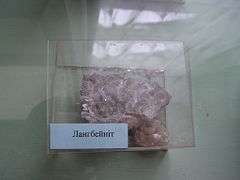Langbeinite
| Langbeinite | |
|---|---|
|
Langbeinite in the History Museum, Truskavets | |
| General | |
| Category | Sulfate mineral |
| Formula (repeating unit) | K2Mg2(SO4)3 |
| Strunz classification | 7.AC.10 |
| Crystal system |
Cubic Tetartoidal class |
| Space group |
Isometric H-M symbol: (23) Space group: P213 |
| Unit cell | a = 9.92 Å; Z = 4 |
| Identification | |
| Color | Colorless with pale shades of yellow, pink, red, green, gray |
| Crystal habit | As nodules, disseminated grains, bedded massive |
| Fracture | Conchoidal |
| Tenacity | Brittle |
| Mohs scale hardness | 3.5 - 4 |
| Luster | Vitreous |
| Diaphaneity | Transparent |
| Specific gravity | 2.83 |
| Optical properties | Isotropic |
| Refractive index | n = 1.5329–1.5347 |
| Solubility | Slowly dissolves in water |
| Other characteristics | Piezoelectric |
| References | [1][2][3] |
Langbeinite is a potassium magnesium sulfate mineral with the chemical formula K2Mg2(SO4)3. Langbeinite crystallizes in the isometric-tetartoidal system as transparent colorless or white with pale tints of yellow to green and violet crystalline masses. It has a vitreous luster. The Mohs hardness is 3.5 to 4 and the specific gravity is 2.83. The crystals are piezoelectric.[1]
The mineral is an ore of potassium and occurs in marine evaporite deposits in association with carnallite, halite and sylvite.[1]
It was first described in 1891 for an occurrence in Wilhelmshall, Halberstadt, Saxony-Anhalt, Germany, and named for A. Langbein of Leopoldshall, Germany.[1][2]
Langbeinite gives its name to the langbeinites, a family of substances with the same cubic structure, a tetrahedral anion, and large and small cations.
Related substances include hydrated salts leonite (K2Mg(SO4)2·4H2O) and picromerite (K2Mg(SO4)2·6H2O).
